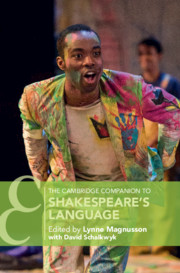66 results
Chapter 33 - Virtue on Robben Island
- from Part III - Shakespeare and Global Virtue Traditions
-
-
- Book:
- Shakespeare and Virtue
- Published online:
- 19 January 2023
- Print publication:
- 26 January 2023, pp 325-333
-
- Chapter
- Export citation
8 - War and Eros
-
-
- Book:
- The Cambridge Companion to Shakespeare and War
- Published online:
- 17 August 2021
- Print publication:
- 14 October 2021, pp 128-144
-
- Chapter
- Export citation
Chapter 20 - Love
- from Part II - Emotions
-
-
- Book:
- Shakespeare and Emotion
- Published online:
- 01 October 2020
- Print publication:
- 22 October 2020, pp 288-301
-
- Chapter
- Export citation
Content but Also Unwell: Distributed Character and Language in The Merchant of Venice
-
-
- Book:
- Shakespeare Survey 72
- Published online:
- 18 September 2019
- Print publication:
- 12 September 2019, pp 243-255
-
- Chapter
- Export citation
Part III - New Technologies
-
- Book:
- The Cambridge Companion to Shakespeare's Language
- Published online:
- 01 July 2019
- Print publication:
- 08 August 2019, pp 149-204
-
- Chapter
- Export citation
Index
-
- Book:
- The Cambridge Companion to Shakespeare's Language
- Published online:
- 01 July 2019
- Print publication:
- 08 August 2019, pp 287-293
-
- Chapter
- Export citation
Contributors
-
- Book:
- The Cambridge Companion to Shakespeare's Language
- Published online:
- 01 July 2019
- Print publication:
- 08 August 2019, pp vii-viii
-
- Chapter
- Export citation
Abbreviations
-
- Book:
- The Cambridge Companion to Shakespeare's Language
- Published online:
- 01 July 2019
- Print publication:
- 08 August 2019, pp xiii-xiv
-
- Chapter
- Export citation
Part IV - Contemporary Sites for Language Change
-
- Book:
- The Cambridge Companion to Shakespeare's Language
- Published online:
- 01 July 2019
- Print publication:
- 08 August 2019, pp 205-261
-
- Chapter
- Export citation
Preface
-
- Book:
- The Cambridge Companion to Shakespeare's Language
- Published online:
- 01 July 2019
- Print publication:
- 08 August 2019, pp ix-xii
-
- Chapter
- Export citation
Part I - Basic Elements
-
- Book:
- The Cambridge Companion to Shakespeare's Language
- Published online:
- 01 July 2019
- Print publication:
- 08 August 2019, pp 1-112
-
- Chapter
- Export citation
Copyright page
-
- Book:
- The Cambridge Companion to Shakespeare's Language
- Published online:
- 01 July 2019
- Print publication:
- 08 August 2019, pp iv-iv
-
- Chapter
- Export citation
Select Bibliography
-
- Book:
- The Cambridge Companion to Shakespeare's Language
- Published online:
- 01 July 2019
- Print publication:
- 08 August 2019, pp 279-286
-
- Chapter
- Export citation
Part II - Shaping Contexts
-
- Book:
- The Cambridge Companion to Shakespeare's Language
- Published online:
- 01 July 2019
- Print publication:
- 08 August 2019, pp 113-148
-
- Chapter
- Export citation
Appendix - Glossary of Rhetorical Figures
-
- Book:
- The Cambridge Companion to Shakespeare's Language
- Published online:
- 01 July 2019
- Print publication:
- 08 August 2019, pp 263-270
-
- Chapter
- Export citation
Contents
-
- Book:
- The Cambridge Companion to Shakespeare's Language
- Published online:
- 01 July 2019
- Print publication:
- 08 August 2019, pp v-vi
-
- Chapter
- Export citation
Further Reading
-
- Book:
- The Cambridge Companion to Shakespeare's Language
- Published online:
- 01 July 2019
- Print publication:
- 08 August 2019, pp 271-278
-
- Chapter
- Export citation
3 - The Performative Power of Shakespeare’s Language
- from Part I - Basic Elements
-
-
- Book:
- The Cambridge Companion to Shakespeare's Language
- Published online:
- 01 July 2019
- Print publication:
- 08 August 2019, pp 35-52
-
- Chapter
- Export citation

The Cambridge Companion to Shakespeare's Language
-
- Published online:
- 01 July 2019
- Print publication:
- 08 August 2019
Chapter 3 - The Impossible Gift of Love
-
- Book:
- Shakespeare, Love and Language
- Published online:
- 12 January 2018
- Print publication:
- 25 January 2018, pp 126-167
-
- Chapter
- Export citation



